Invisible Earplugs for Clubbing
Clubbing without earplugs can easily hurt your hearing. But going with earplugs has the problem that others might notice. And you might get picked on for wearing them.
Can it not be had both ways? Hearing protection and nobody noticing it?
Fortunately it is possible. The two best options are hidden foam earplugs and the weaker reusable earplugs. Which to wear depends mostly on how loud the music is.
Below you will find a discussion of the different types and recommendations for the best brands considering invisibility and also sound quality.
Foam Earplugs
Foam earplugs is what people think of when hearing the word “earplugs”. They are the most widely used hearing protection. Unfortunately, they are almost always colored in aggressive yellow , green, white, or range. These strong coloring makes them visible for anyone glancing at you.
Foam earplugs provide stronger sound protection than reusable earplugs. Compare for example the Bilsom 303 foam earplug to the going to be mentioned reusable earplug ACS Pacato.
If foam earplugs are so visible, why do we talk about them here?
Foam ear plugs can be very well hidden. In fact, they are the most discreet ear protection available if used correctly.
And foam earplugs provide sufficient protection for loud clubs or concerts.
There are 4 steps involved to hide them 100%:
First, use flesh colored earplugs instead. There are a few brands available such as the Hearos Ultimate Softness Series shown in the picture below.

Second, paint the ear plugs black. If you cannot get flesh colored earplugs, simply paint your earplugs black. This makes them much less visible. Even fleshed colored earplugs can be improved by painting them. A black permanent marker can get the job done as shown in the picture below.
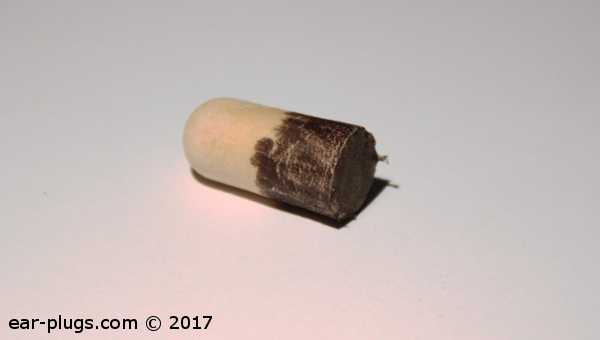
Third, insert the earplugs properly into the ear canal. Earplugs are supposed to be worn around ⅔ to ¾ in your ear canal. Many novice or inexperienced foam earplug users fail to insert them properly. The result is that ½ or even more of the earplug remains in the outer ear. This makes them more visible and also impairs the hearing protection. To insert a foam earplug correctly, place them in one hand and roll them between your fingers until you have a small compressed stem like in the picture below. Then insert this stem into your ear canal and wait for it to expand. The two pictures below show it.
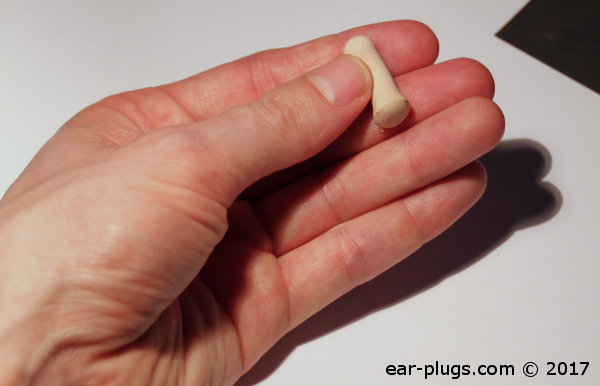
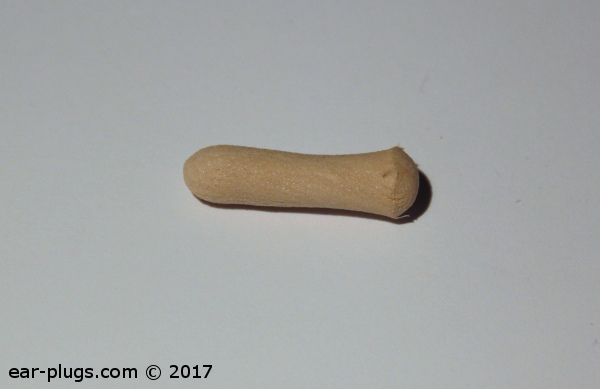
Fourth, cut the earplug shorter by up to by ¼. When an uncut earplug is properly inserted approximately ¼ remains in the outer ear. If you cut that part away, then it will not be there anymore. This makes the earplug very difficult to spot for others. But the hearing protection will also suffer from it. In our own experience, the sound protection is still sufficient and still ways stronger than reusable earplugs. We do not accept any liability for this tip or any other tips. If you every have trouble getting a cut earplug out of your ear again, then use tweezers once you are back home.
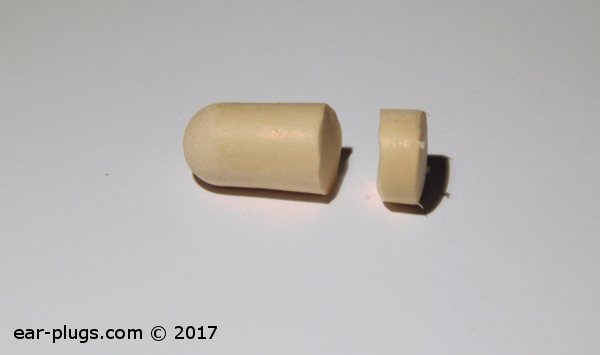
If all of the above steps are applied, then a foam earplug will be 100% invisible to anyone else. The end result is shown in the picture below.
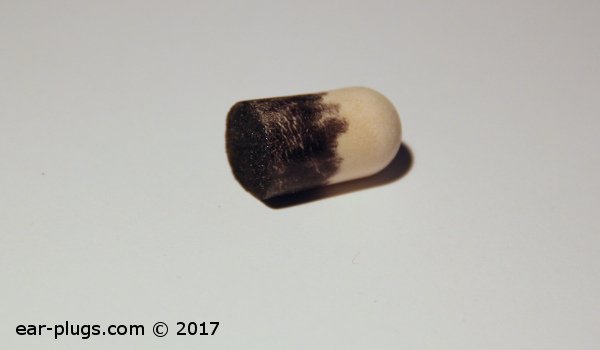
A more detailed description is available in our article on how to make foam earplugs invisible.
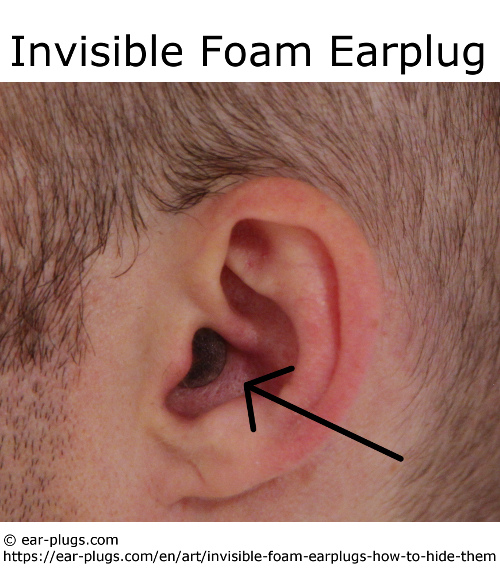
Foam earplugs provide strong sound protection. As long as you are at the loud spots of the club or on the dancefloor, you can understand what other people are saying as good as without plugs. You probably even understand them better than without earplugs, because your ears work better when everything is quiet down a bit
But when changing to quieter place such as going outside, having a drink at a separated bar, or going to toilet, you will probably want to take the plugs out, if you stay there for longer than just 2-3 minutes. Else you will probably be having difficulty conversing with people.
The difference in sound quality is huge for different brands of foam earplugs. We like the Bilsom 303S or Laser Light very much. Their sound quality is significantly better than for other earplugs. They are not available in flesh color, but painting them black helps. It will improve your listening to music experience meaningfully.
Reusable Earplugs
There at least a few brands of reusable earplugs that hard to spot for others. The manufacturers often advertise their plugs as especially made for concerts, partying, and clubbing.
Reusable earplugs are weak compared to foam earplugs. They will not provide enough hearing protection for loud clubs if you do not want to risk any hearing damage. But they are certainly much better than no hearing protection at all.
They are best used when the club is not so loud.
Reusable earplugs provide superior sound quality compared to foam earplugs. And because reusable earplugs are weaker, you can more easily talk with other people when changing to a quieter area of the club. With foam earplugs this becomes challenging and you might have to take them out when changing to a quieter area with bar, lounge, smoking room, or whatever.
Let’s look at the available brands. We start with the best plugs considering invisibility.
ACS Pacato

The ACS Pacato provides medium hearing protection and is almost invisible.
The Etymotic Research ER20XS
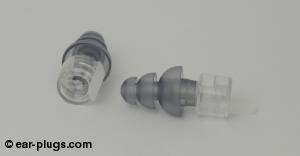
The ER20XS provide among the best sound quality of any reusable earplugs. The sound quality is better than the ACS Pacato. But they are ways more visible than the ACS Pacato.
Alpine Hearing Protection
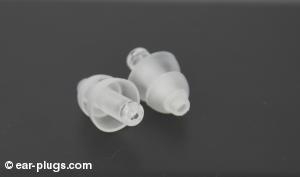
The Alpine Party Plugs are a very popular brand. They are more visible than the ACS Pacato due to the stem sticking out of the ear. They are available in transparent, which lessens the visibility somewhat. We think that the sound quality is worse than the ACS Pacato or the ER20XS.
Others Picking on You
Very few people usually wear earplugs when going clubbing.
Many people are more afraid of being ridiculed or seen as not cool by their peers for wearing earplugs than suffering hearing damage.
With invisible earplugs, you will not have that problem.
Invisibility of Earplugs at Clubs
The lightening is usually dimmed at night clubs. This is an advantage for hiding earplugs. If you have the ACS Pacato or painted foam earplugs, they will be almost impossible to notice for others. Certainly, they are not noticeable to anyone standing in front of you and talking to you. But also other people are unlikely to notice them.
Should you get intimately close to someone else at the club, then they may notice. But at that stage in the interaction it should not matter anymore.
Why it is Strongly Advisable to Wear Earplugs When Clubbing
The loudness of sound is measured in decibel (dB). More decibel means louder sound.
For the risk of hearing damage, it is important how loud the sound is and how long you are exposed to it.
The National Institute for Occupational Safety and Health (NIOSH) has released safety guidelines for work places. Have a brief look at the following table. It shows how many minutes a worker might be exposed to loud noises safely per day.
| Loudness dB | How long it is safe per day | Description (indicative) |
|---|---|---|
| 30 | full day | whispering |
| 60 | full day | normal conversation |
| 80 | full day | |
| 85 | 8h | |
| 90 | 2h 31min | passing motorcycle, subway, loud restaurant |
| 95 | 47min | power mower |
| 100 | 15min | normal club |
| 105 | 4min 43s | normal club |
| 110 | 1min 29s | loud club, chainsaw |
| 115 | 28s | loud concerts |
| 120 | 9s | very loud club, standing at speakers |
For example, if you are exposed for 2 hours 31 minutes to 90dB (loud restaurant) then your daily budget of noise exposure is used up and one should only be exposed to sounds below 80dB during the rest of the day (or before during the day).
Most clubs are at a 100 dB and more. If you look at the above table you can see that the safe time at 100dB is very short with only 15 minutes permitted exposure time per day.
The above table is certainly conservative, because it is used for workers safety to noise that they are exposed to daily. But even if one deducted some margin from the table, the message does not change. Even when deducing a large margin, the message still stays the same. The sound level at clubs is ways too loud to be safe (most clubs are at more than 100dB).
You are almost guaranteed to suffer some hearing damage when staying in a club more than just a few minutes without hearing protection.
Hearing damage can occur in different forms.
Often people have a piping or ringing sound in the ear after leaving the club. The ears might also be partially deaf to quieter sounds of certain frequencies. Mostly, the ears recover within a few hours to a few days and everything is back as it used to be, or almost.
There is a problem with the “almost". Hearing damage is cumulative. Although you might not realize a difference between your hearing before going the club and a few days after the clubbing, there might still be small damage left. And if you go clubbing often, these small damages can accumulate until you have hearing problems later on in life.
It you get really unlucky, the piping sound or partial deafness after a clubbing event might stay forever. If the piping sound stays then it is called tinnitus. The spectrum of tinnitus goes from quiet, which is only heard in silence, up to so loud, that people cannot fall asleep anymore without medication.
Therefore it is best to always have earplugs in the pockets when going clubbing. Then clubbing can be a good experience without anything to regret afterwards for decades to come.
Professional Musicians Earplugs
There are professional musicians earplugs available such as the ER25. They have an extremely good sound quality. Wearing them is just like a volume knob turned down a bit. They are also available sufficiently strong for almost all clubs or concerts. Unfortunately, they are more visible than the best reusable earplugs or foam earplugs. And they are also more expensive.
Other Types of Earplugs
There are also wax earplugs available. They are more visible than the best reusable or foam earplugs and have worse sound quality.
Other Articles
If you are interested in the sound quality of earplugs then read our article on earplugs for listening to music. Click here to see a list of all our articles.
Posted on
Last updated on